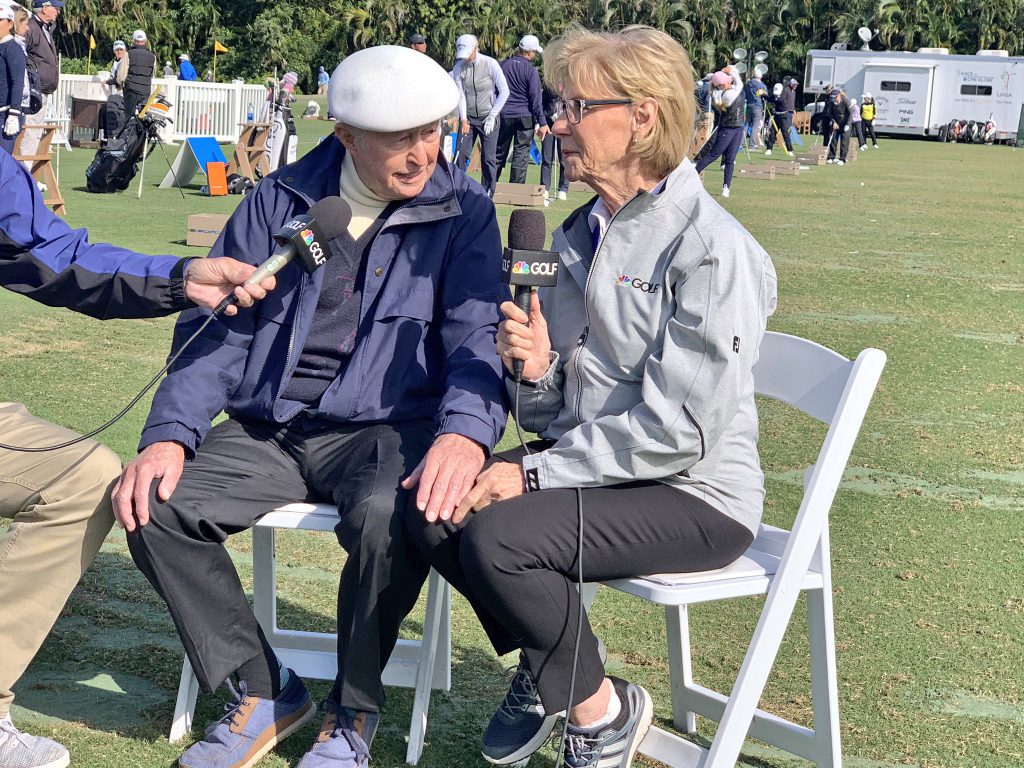By Travis Puterbaugh, World Golf Hall of Fame Curator
Let’s go back to Wednesday morning, the week of the first full-field event of the 2020 LPGA season. – the Gainbridge LPGA at Boca Rio.
World Golf Hall of Famer Judy Rankin, who has covered golf since 1984, is on hand to cover the tournament for Golf Channel. She meanders up and down the driving range, checking out some of the new, rookie talent as well as the familiar stalwarts of the LPGA Tour. It is part of her pre-tournament ritual, a routine as natural and comfortable to her as swimming is to a fish.
While there, Rankin runs into her former coach and PGA of America Hall of Famer Bob Toski.
It is an emotional reunion, as there is clearly still great affection and mutual admiration between the pupil and her one-time teacher. They sit down for an on-camera interview conducted by Golf Channel’s Jerry Foltz, which will air during the following day’s broadcast. Toski, who was the first person other than Rankin’s father to ever have a significant role in shaping her golf game, calls Rankin “probably the best student he ever had.”
For her part, Rankin says that the root of many of the things she tries to explain during broadcasts were learned from Toski. So, by extension, golf viewers who have enjoyed Rankin’s work over the last four decades owe some small debt to Toski. The rest, well, is just naturally Judy, a personality who is such a familiar and welcome presence to golf fans that she has become synonymous with televised golf.
 Bob Toski and Judy Rankin, Photo by Beth Ann Nichols (Golfweek)
Bob Toski and Judy Rankin, Photo by Beth Ann Nichols (Golfweek)
Once described as a “trusted, no-nonsense communicator who imparts pure professionalism,” there may never have been a more accurate or fitting description of what Rankin brings to the table as a broadcaster. For someone as revered and respected as Rankin, there’s no shortage of people who can describe what makes her so special.
“She’s just a walking legend,” recalls Paige Mackenzie, who as a colleague of Rankin’s at Golf Channel and a former player on the LPGA Tour, has gotten to know her from both sides of the camera. “She made time to say hello and get to know me. I always trusted that she would get it right, because she made the time to get to know the players.”
For Mackenzie, Rankin’s personal touch translates into a style that easily resonates with golf fans, and to players on the Tour.
“It feels like she’s talking with you, not at you,” Mackenzie says. “For me, as a player and fellow announcer, she has a tremendous gift of being critical with compassion. She has never forgotten how difficult the game can be and how cruel some days feel. Judy is able to capture that emotion in her critical analysis, and it is something I appreciated as a player, and something I admire as a broadcaster.”
Empathy resides at the core of what makes Rankin such a trusted and respected voice in golf, because she too has experienced the difficulties of trying to make a living playing the sport. She struggled early in her career and considered giving it up all together. To her, empathy comes second nature.
“I think it’s just me being myself,” Rankin says. “If I learned anything as a player, it’s that the game is hard. I do have empathy for people when it goes south.”
There were times in her own playing career when things could have easily gone south for Rankin, who turned professional at the age of 17. She said in a 1978 interview with Fairway Magazine, that she “always had a gut feeling” she wouldn’t make it.
But make it, she did.
In 1976, Rankin became the first female golf professional to earn more than $100,000 in a season. She led the money list again in 1977 with $122,890. She won 26 times on the LPGA Tour; earned the Vare Trophy three times for lowest scoring average (1973, 1976 and 1977); captured consecutive Golf Digest Mickey Wright Awards for most victories in a season on the LPGA Tour; posted a record 25 top-10 finishes in 1977; and won back-to-back LPGA Player of the Year awards in 1976 and 1977.
Her pedigree in golf and list of accomplishments confers on her what fellow Hall of Famer Beth Daniel describes as instant credibility with viewers. Daniel, who worked alongside Rankin at CBS in the booth and for Golf Channel as an on-course reporter, says that she takes a job which requires great preparation and attention to detail and makes it seem effortless.
“Some people do it with more ease than others,” Daniel says, “and Judy is definitely one of the ones that does it with ease. A lot of announcers will over-talk, but Judy doesn’t do that. She lets the golf happen, and then she will interject.”
“Very few people say more with fewer words than Judy,” says Mike Tirico, her one-time colleague at ABC Sports and now the voice of golf at NBC. “And that only comes with a great knowledge of the game.”
Daniel adds that Rankin doesn’t “vie for attention. She just does her job and tries to help the people around her. She’ll set you up with a question she knows you can answer. There’s a lot of competition in this business, and Judy has never been the person to take someone else out to make herself look better. She wants the whole telecast to be good so she’s very professional that way.”
Part of making a good telecast is being prepared, and Rankin will put in the work equally whether she is covering a Major Championship, a Solheim Cup, or in this case, the first week of the season at a new event and course on the LPGA Tour.
In many respects, the first week of the season offers its own sets of challenges, from learning the games of LPGA rookies to catching up with coaches, caddies and players on their off-seasons, as well as becoming familiar with a new golf course.
“In a tournament like this, it is a bit more complicated because we have never been here before,” Rankin says, “so you try to get yourself up to speed with the golf course, what the players see, where the trouble spots may be… those sort of little things, just so you can be informed when they play a hole.
“That’s important to what we do, but an awful lot of what’s important to what we do is having on-course people out there. The actual role of them on the golf course and our conversations is the big thing that gets us familiar with the course.”
During the first-round broadcast, Rankin was quick to note that she spoke with the rules officials that morning and shared information that not one piece of ground was marked under repair on the golf course, and that caddies and players were reporting that the course was playing soft. In other words, important information to know about a course unknown to viewers and hosting an event for the first time.
She adds that no amount of preparation or planning can dictate what will actually happen on the golf course, and they can only hope for something compelling for the viewers.
“We alone cannot make the show exciting,” she says. “The only thing that ever really makes the show exciting is when we get good golf. I think often some people expect us to come up with something to make it a riveting show, and we all know what makes for a riveting show is a great contest and good golf. When it gets fun for us, fun for the players, and fun for the viewers, is when it’s really a great contest with a great back-and-forth with one, two or several players. That’s when golf on television is the best.”
That is exactly what happened on Sunday at the Gainbridge LPGA at Boca Rio, offering viewers a compelling back-nine in which Nasa Hataoka, Danielle Kang, Sei Young Kim, and eventual winner Madelene Sagstrom all jockeyed for position atop the leaderboard, with the tournament coming down to the final putt, missed in dramatic fashion by Hataoka.
Presciently, right before Hataoka missed a four-footer which would have forced a playoff with Sagstrom, Rankin said, “I’m guessing this looks like a straight-in putt, Jerry, but there’s nothing easy about it.” After the miss, the ever-compassionate Rankin quickly added that “it was such a hard putt for Nasa to have to make.”
Rankin has been in her shoes. She knows.
She would be the first to admit, however, that beyond preparation or dramatic play on the course, what goes into making a great broadcast is having a wonderful, professional team around her; from producers and editors in the trailer, to cameramen and on-course reporters, to her colleagues in the booth. Whether she is sitting next to Terry Gannon or Grant Boone, or checking in on the course with Foltz, Karen Stupples or Tom Abbott, the chemistry this group shares is undeniable.
It certainly comes across when Abbott and Boone playfully tease Rankin about getting up on stage for karaoke, or, when the image of a helicopter is shown flying by the golf course, joking that she’ll soon be whisked away to enjoy some nightlife in nearby Miami. She takes it in stride and laughs, knowing that the humor is in good nature, and she may even have a chance to return the favor later in the broadcast.
Inside the booth, Gannon and Boone bring their own styles and approaches in collaborating with Rankin. As she describes it, Gannon has a great feel for TV and instincts for where a conversation should lead. Boone enjoys bouncing ideas off Rankin and letting her go where she is most comfortable. Rankin says she is comfortable following their leads, but is not afraid to disagree at times.
“If I have a real strong opinion, they listen to me,” she says. “We have a good relationship in that regard. There may be some things about golf I think I may know better, but there are other things about the television part of what we’re doing that they know better.
“Sometimes I may have an idea that golf-wise may be a little cerebral, or a little deeper with golf to talk about in the opening, and Terry will say to me ‘Judy, that is not going to draw in any viewers.’”
“So now we know that is not where I should go,” Rankin says as she laughs. “Everybody on our crew tries to help each other and make our work look good. I’m friendly with all of them, and I think that comes across and it is real.”
The friendships with her TV family are what she’ll miss the most when her run at Golf Channel comes to an end, a fact she acknowledges is no longer in the distant future.
“I feel like I spend a lot of time around a lot of young people,” Rankin says, “and I know my son always tells me how good that is for me. So, some things – not just the career – but some things for me will change dramatically when I’m not doing TV any longer. A lot of these road friendships have been real friendships. I will really miss that, so maybe I’ll just come visit once or twice a year.”
The players, colleagues and fans who enjoy her work wouldn’t want it any other way.

